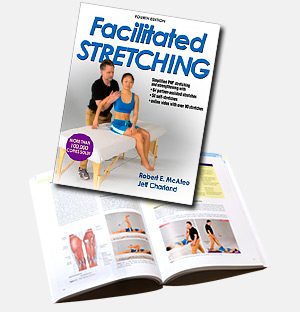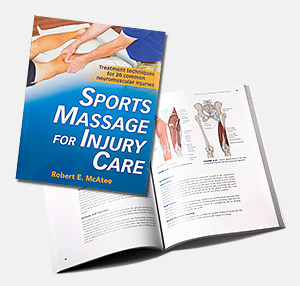By Bob McAtee RMT, CSCS, C-PT
As massage therapists, we have the ability to work with injuries to the soft tissues in a way that few other practitioners do.
If you think about it, massage practitioners are really the primary source for the hands-on care for most minor soft-tissue injuries. How many people you know go to the doctor for minor aches and pains? How many of your clients ask you to treat these same aches and pains? This is well within our scope of practice, as long as we are able to properly evaluate the injury, and determine if it’s a problem we’re qualified to treat. However, treating the injury without determining its source leaves the client susceptible to re-injury.
Broad Based Knowledge Needed
To get to the source of the injury, we must be knowledgeable in many areas, including effective evaluation and assessment techniques, biomechanics, basic diet and nutrition, and the myriad details related to the clients’ activities and how they affect the body. We must then apply this knowledge as appropriate, to help our clients recover from their injuries, and to help prevent their reoccurrence.
Soft-Tissue Healing
Injured soft-tissue typically heals by forming scar tissue, also referred to as fibrotic tissue or fibrosis. If healing progresses properly, the injury heals with no further complications. In many cases, however, a minor injury can heal with improperly formed scar tissue, leading to chronic and nagging aches and pains, limited joint mobility, or both.
Tissue healing proceeds through three phases, which overlap each other in a continuous sequence. These are inflammation, proliferation, and remodeling.
The inflammation stage of healing is characterized by heat, swelling and pain. During this phase, typical treatment includes methods for controlling heat and swelling, such as cryotherapy, anti-inflammatory medication, and rest of the injured tissue. Uncontrolled inflammation may interfere with the normal progression to the next healing phase, and set the stage for chronic low-grade inflammation to persist.
The second stage of healing is called the proliferation, or granulation, phase. In this phase, the body manufactures scar tissue to repair the damage. If healing proceeds appropriately, the scarring will be minimal and the damaged tissue will be able to function as designed. If healing is compromised, then the scar will form as a dense, inflexible mass.
Remodeling, the third phase of healing, is a continuous process of adding and taking away until the scar is just the right size and shape. When healing progresses naturally, this leaves the injured tissue as functional as it was prior to the trauma. When chronic sub-acute inflammation continues in the tissue, the remodeling seems to shut down before it’s complete, leaving a non-functional scar that limits pain-free movement and may irritate surrounding, healthy tissue, leading to more pain.
Facilitated Stretching
One technique that is extremely useful in the treatment and rehabilitation of soft tissue injuries is facilitated stretching. When used appropriately, facilitated stretching can safely and effectively help restore suppleness and flexibility to injured muscles.
Massage alone can be effective in reducing pain and restoring flexibility to fibrotic tissue, but the addition of facilitated stretching can foster a dramatic reduction in the overall healing time and the restoration of pain-free motion.
Stretching in Three Easy Steps
Facilitated stretching uses a three-step protocol to achieve increased range-of-motion (ROM):
- Actively lengthen the target muscle to its current end-range.
- Contract it isometrically for 6 seconds.
- Then actively stretch the target muscle to a new ROM.
When using facilitated stretching in conjunction with massage techniques to help rehabilitate injured tissue, we can focus the isometric contraction and subsequent stretch to a specific area of the muscle, like a patch of scar tissue to which we have just administered transverse friction work or some other form of deep massage. The isometric contraction further activates the muscle and prepares the fibers to lengthen. It may also help to break free adhesions that have just been softened by the massage technique.
The stretch phase of the facilitated stretch occurs when the opposing muscle contracts concentrically, lengthening the target muscle. We can position the limb so that the client feels the stretch through the area that we’ve been working, thereby maximizing the effects of the stretch to that area. Once again, we are theoretically breaking unwanted adhesions and cross-links in the collagen fibers as the muscle lengthens, restoring pain-free motion.
Releasing the Hip, Side-Lying
An example of a session that combines stretching and soft-tissue work will help bring it all together.
The side-lying position provides excellent access for working on the hip abductors. The majority of clients we have treated over the years have had abductor involvement, no matter their primary complaint. Because the abductors act more as postural muscles than as prime movers, they can become extremely hypertonic, fibrotic, and tender to palpation, even though the client may not be experiencing any overt symptoms.
The side-lying position also allows easy access to the oblique abdominal muscles, the quadratus lumborum, and the latissimus dorsi. These muscles can all be involved when the client has “hip issues.”
Position the client side-lying, hips stacked vertically, bottom leg flexed toward the chest, top leg hanging off the back of the treatment table.
At this point, the client can usually pinpoint an area of slight to moderate discomfort in the hip abductor group. Try using a couple of rounds of facilitated stretching to reduce or eliminate this discomfort; then ask the client to identify any continuing sense of restriction or discomfort. Typically, the client will be able to isolate a very small area or point of restriction.
Apply some form of soft tissue work (like transverse friction, myofascial release, etc.) to the site of restriction for a minute or so; then check with the client to see if anything has changed. It’s not uncommon to see a spontaneous improvement in ROM and for the client to report that the discomfort is now gone.The client will also usually be able to identify a new area of discomfort, most often higher up on the iliac crest, along the attachment of the oblique abdominal muscles. You can continue to repeat the sequence of stretch and soft tissue work until you clear the entire area.
Results
© 2006 by Robert E. McAteeI’ve been using massage and facilitated stretching together for many years now and am continually amazed at the effectiveness of this combination when working with soft tissue injuries. I believe you’ll find it to be a useful addition to your repertoire of skills.
Portions of this article are adapted from Facilitated Stretching, 3rd edition, © 2007 Human Kinetics and used by permission.


